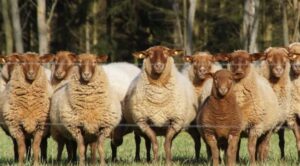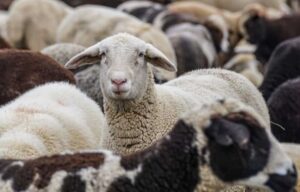Sheep Farming in Philippines: On local farms, keeping sheep can be just as profitable as doing the same with goats. Sheep, which are used for their meat, wool, and skin, help with food production, rural jobs, and the national economy. Mutton is not often consumed by Filipinos, however there is a developing market for the meat and it may be exported.

Sheep Farming in Philippines
The best location for Sheep farming in the Philippines
- The placement must follow the local area’s land use plan. Service roads, a water supply, and power lines must all be able to reach the site.
- The area must have good drainage and free airflow. The structure for marketable animals will be next to the service road, and the building will be constructed in an east-west direction. The site must be situated so the farmhouse will not be affected by the direction of the wind.
Why should you do Sheep farming?
Sheep are produced primarily for their wool, milk, and dung. Meat is not only delicious but also filling, and it is favored by all demographics around the world. But let us say you want to choose the company that will make you the greatest money. In that situation, raising sheep can be a terrific option because it can help reduce poverty in arid, desert, semi-arid, and mountainous places.
What sheep breeds are most prevalent in the Philippines?
The majority of the country’s sheep are native to the Philippines and are found in small flocks all throughout the place. The Poll Dorset, Rambouillet Merino, St. Croix, and Katahdin (found on a few government stock farms), Barbados Blackbelly (found on a few commercial or institutional farms), Border Leicester, and Suffolk (which have extremely tiny populations) are among these exotic breeds.
These sheep breeds can also be crossed and improved. Sheep are mostly raised for their meat. Two of the most significant subsectors of the Philippine agricultural sector are livestock and poultry. Among all the animals raised for human use, they produce the majority of the nation’s livestock.
In addition to the “native sheep,” the nation also produces the Shropsire, Southdowners, Poll Dorset, Rambouillet, and Suffolk types of sheep. Barbados black-bellied sheep have recently been brought to the nation by religious missions and international civic organizations. The latter is thought to be flexible enough to adapt to Philippine circumstances.
Sheep production methods in the Philippines
Intensive accelerated : Total confinement entails providing for ewes and lambs’ requirements while maximizing productivity. Ewes and lambs are housed in barns or corrals all year long. To improve the likelihood of multiple births, ewes are flushed (given grain prior to breeding). To fulfill their expanding nutritional requirements and keep the lamb at a high level, grain is also provided to lambs before and throughout nursing. The lambs will also be given creeps to eat. All animals should have access to clean water, salt, and minerals. Although confinement is typically a more expensive manufacturing technique, it can boost output and revenue.

Semi-confinement: While ewes graze on grass after weaning, lambs are kept in confinement until market weight and fed creep. In winter, ewes in captivity are fed.
Range/grass based: It is a classic production technique. Late autumn ewes are raised in pastures in preparation for spring lambing. The summer is spent grazing ewes and lambs, and the fall market season is when lambs are sent. Some farmers use unique grazing programs to supply summer rangeland. In rangeland habitats, predator management presents a significant difficulty. Electric fences and the addition of guard dogs or donkeys, however, have greatly decreased the losses.
Are sheep able to be raised in the Philippines?
On local farms, keeping sheep can be just as profitable as doing the same with goats. Sheep, which are used for their meat, wool, and hides, boost food production, rural jobs, and the national economy. Small-acreage farms can offer enough room for productive sheep raising. Profitability in sheep farming might be challenging, but it is achievable with productive herds and strict cost control. Sheep primarily make money from the sale of meat, wool, and milk.
Is Sheep native in the Philippines?
The Philippines has a lengthy history with sheep. It came to this country during the Spanish era. The Spanish Merino sheep that we now refer to as “native” was introduced to the nation by the Spanish during the Galleon trade between Mexico and the Philippines.
In the Philippines, native sheep are grown largely as goats. Sheep are either kept/reared in semi-captivity, tethered, or allowed to graze. Sheep are typically raised for meat, as pets, and very infrequently as livestock for sale to supplement the family’s income. However, the indigenous stock’s generally high levels of quantitative diversity may point to the possibility of improving Philippine sheep performance with suitable management and breeding.
Decide the reason why you want to raise the Sheep
For their wool, skin, meat, and milk; for hobby farming purposes to obtain organic domestic meat and other products; for plant control; or to become pets, sheep are raised for a variety of reasons. So, unless you have the required time, sufficient experience, sufficient resources, and sufficient pasture, do not overextend.
Benefits of Sheep farming in the Philippines
- Meat, wool, skin, manure, milk, and transportation are all multipurpose materials.
- Sheep do not require expensive housing and can be raised on farms alongside other animals in tiny spaces.
- Sheep farming is less labor-intensive and offers a wide range of financial rewards. Sheep may even live on poor-quality grass.
- They produce milk, meat, and wool, all of which have different uses. With the right management, this company can provide both employment and a reliable stream of income from sheep husbandry. The price of one does not always affect the other because the two main sheep products (wool and mutton/meat) are produced and consumed relatively differently
- Lambs can be marketed after five to six months (ideally before a year), with a very quick return.
- It is best to use dryland areas’ scant vegetation through rangeland management and cultivated pastures.
- It is more adaptable to dry and semi-arid tropical regions with marginal and sub-marginal lands that are otherwise unsuitable for crops because of improved water and food (particularly protein) economies.
- The fact that sheep consume a wider variety of plants than any other livestock allows them to turn waste into profit and enhance the aesthetics of many farms (by using the best herbs).
- Sheep graze on subsoils and provide valuable fertilizer; their droppings can enhance plant growth in certain regions.

Understand basic Sheep care for successful production
Sheep could need basic care, including food, drink, housing, and cleaning. Make sure the flock has daily access to clean water, fresh hay, and grass. As it takes relatively little upkeep, it is quite promising. Extra attention may be needed if you are breeding sheep for meat or wool. Sheep can be raised in orchards, along roadside ditches, and empty fields since they breed quickly. The most recent data regarding your sheep farming operation can be found in farm management software.
Sheep must be properly cared for in order to maintain their health. Please make sure that the water is pure and that there is enough shade for them throughout the summer. One of the largest costs for a sheep farming enterprise is feed. The majority of ruminant animals’ nourishment comes from hay and pasture. Unfortunately, the limited space prevents the production of a lot of feed. To be lucrative, it is crucial to locate low-cost suppliers of high-quality hay or adequate grazing pasture.
To achieve a successful feeding plan, it is vital to consider the accessibility of feed resources, processing and handling equipment, cost, production stage, external environment, and production objectives. To make sure that the rations you provide your animals are appropriate for their needs, it is crucial to collaborate with a nutritionist. It might be essential to flush the ewes with feed for a few weeks prior to and throughout the breeding season if they are not in prime condition.
It ought to boost the percentage of lambs born. For the sake of keeping things in good shape, rams should also be fed grain at these times. The quality of the grain supplied, the quantity and kind of supplementary feeds, and the stage of production, particularly the number of lambs raised, will all affect the amount of grain and further supplementation during other phases of development.
Basic requirements in Sheep farming in the Philippines
Prepare a shelter for the winter: Sheep require shelter in the rain or winter. A flock can fit in a small pen. Sheep with thick coats can endure cold temperatures, but first consult with knowledgeable sheep breeders. In the event that you reside in a temperate area, the barn’s three walls will aid in air circulation. In order to keep sheep in such a location throughout the winter, you must construct a stable and ensure that they are protected from the wind. However, you should take the sheep outside during the day. Wet weather is abhorrent to sheep. You might require an indoor cage if you reside in an area that experiences a lot of rain.
Water: All sheep should have access to fresh water, even newborn lambs. Test the water for quality parameters just like you would feed. It is possible to use the knowledge to reduce any potential toxicities and inadequacies.
Strong fencing: If you let them graze on a pasture, you should have a suitable fence. The fence must be sturdy enough for them to be unable to escape and remain inside safely. All types of predators will be kept out if the fence is effective. It is advised to use a wire or woven fence. A non-electric fence made of plain or woven wire works well for sheep fencing. For temporary paddocks, electric mesh fences are used. Sheep require shade from trees or open roof structures during the hot summer months and in warm areas.

During these times, make sure kids have access to plenty of clean, cool water. Sheep do not require a lot of defense. To shield themselves from the worst of the rain, cold, snow, and wind, they prefer a straightforward, south-facing, three-sided structure. Each adult sheep should have between 15 and 20 square feet in the shed. If sheep give birth to lambs in the cold, that is one exception.
If so, the young animals must be protected with a tiny barn or a sturdy, covered shed. Even in tiny flocks, individual sheep occasionally require care, necessitating confinement in some handling facilities so that the animals can receive shearing or medical attention. It could be a cradle that is pretty basic or a forced pen. Compared to chasing animals and attempting to capture them for handling, it will be far safer.
Good maintenance
You must properly care for and manage your sheep if you want to make the most money from your sheep farming enterprise. It is advisable to invest in prolific and high-quality breeds, feed them wholesome food, and give them sufficient habitat.
Commercial Sheep production in the Philippines
Small ruminant production is carried out in high sheds or sheep houses, either partially or completely enclosed. Animals can graze on open grasslands, scrubland, or beneath tree crops under the semi-captive system. These animals are herded at night in elevated homes or covered lanes. On the other hand, goats raised in total confinement are always housed in sheds or barns, which are typically tall with slotted floors.
Goats that are completely contained are fed a mixture of hay, legumes, and feed concentrates. To maintain the good health state of these animals, appropriate medical treatment and biosecurity precautions are also offered. Both species are permitted to share open grasslands, bare fields, and under-tree crops during the day on farms where goats and sheep are produced.
The sheep are kept penned in separate sheds at night. Commercial sheep farms mostly sell their sheep as breeding stock. But the dead animals are also offered for sale for slaughter in neighborhood public markets. Although some enhanced local sheep can also be found on commercial farms, the majority of the sheep bred there are exotic species.
Management of feeding for sheep husbandry
Given that they make up 70% of production expenditures, it is crucial to think carefully about the feeds to offer during fattening. Water and dry stuff must both be present in the meal. Forage and concentrate are two examples of the organic and inorganic components that make up dry matter. While tubers (cassava, yam, or potato), grains (maize, sorghum, soybeans, peanuts, etc.), and animal protein (fish meal) can be concentrated, forage can comprise green leaves, grass clippings, legumes, etc.
3.1% of its body weight in feed should be consumed each day. Concentrates can be consumed at a daily dosage of 2.5% of body weight. Always have access to clean drinking water. Making sure there is high-quality pasture is essential for feeding sheep. Hay, certain pellet diets, and salt lick blocks should be used to supplement poor pasture. You will have to feed the sheep every day if they can not graze, such as during the winter when there is snow on the ground or during a drought when pasture is scarce or nonexistent.

It varies based on the region of the province and occasionally the type of sheep. In the province’s selenium-deficient areas, selenium supplements should be taken. Additionally, it is crucial to make sure the herd receives enough vitamin A, D, and E. There are numerous varieties of vitamin and mineral supplements on the market. For the best diet for your procedure, see a nutritionist.
If you do not farm full-time, take this option into consideration because it takes time. Feeding should be based on body condition because ewes and rams with extra fat typically have trouble getting pregnant. Salt and minerals/vitamins must always be available to sheep. Copper sensitivity in sheep makes cattle with higher mineral levels unsuitable for the typical sheep herd.
Diseases and their control in the Philippines’ sheep farming industry
Serious illnesses and parasites can be greatly reduced in sheep flocks by using the right feed and management practices. At least once a year, sheep should receive injectable or drenching treatment for both internal and exterior parasites. It is advised to immunize lambs using an eight-way vaccination against clostridial infections. It is crucial to give booster doses to maintain annual immunity levels. Lambs should also receive an enterotoxemia vaccine (also known as pulpy kidney disease or overfeeding illness).
Before lambing, the flock may occasionally need to receive a vaccination against the illness. There are numerous vaccinations available to treat clostridial and enterotoxemia illnesses. Additionally, maintain the sheep healthy and pest-free. Make careful you periodically worm the sheep with a sheep-specific commercial worming paste. Other safety measures include immersing sheep to prevent bug infestation and, in certain locations, docking tails to prevent disease spread by flies.
Take the necessary procedures to safeguard your sheep if you live in an area where foot-and-mouth disease is a problem. For advice on the best and most compassionate way to keep your sheep healthy, talk to a veterinarian. In addition, the routine listed below should be used to keep lambs healthy.
- To make sure that no fresh lambs are infected, quarantine them for one to two days.
- Give the newborn lambs worming medication.
- Give sick lambs the proper treatment and keep them apart from healthy lambs.

Vaccination: Give your sheep their shots on schedule. They will be shielded from a variety of illnesses. To be able to seek aid at any time, one should always have a good relationship with their doctor.
Conclusion
In the Philippines, raising sheep is satisfying, whether it is done for a living, as a source of food for the family, or as a hobby. However, successful sheep farming demands careful planning and dependable farm management. In the Philippines, sheep farming is the practice of breeding and maintaining sheep on a farm for commercial purposes. As a result, it also involves tending, guarding, managing, etc. Additionally, it provides details on regional weather, breeds, farming practices, and markets.


